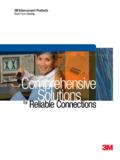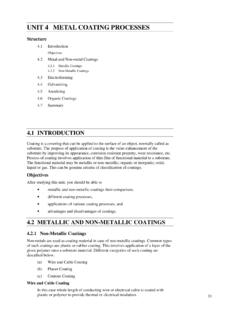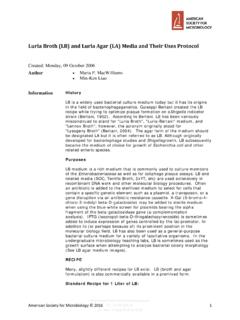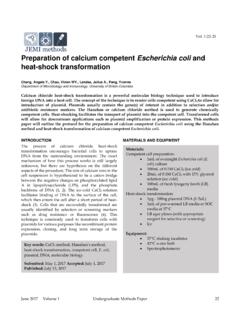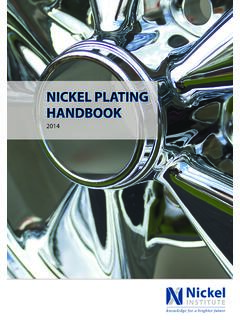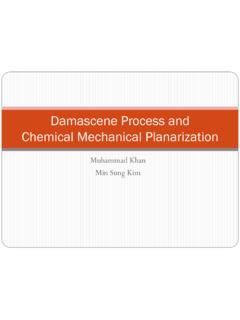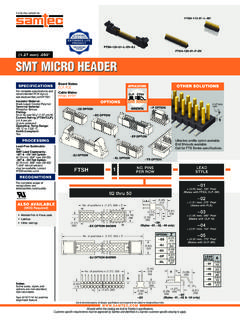Transcription of FactSheet - Occupational Safety and Health Administration
1 Breathing small amounts of hexavalent chromiumeven for long periods does not cause respiratorytract irritation in most people. Some employeesbecome allergic to hexavalentchromium so that inhaling chromate compoundscan cause asthma symptoms such as wheezingand shortness of hexavalent chromium affects the skinSome employees can also develop an allergicskin reaction, called allergic contact occurs from handling liquids or solids con-taining hexavalent chromium . Once an employeebecomes allergic, brief skin contact causesswelling and a red, itchy rash that becomes crustyand thickened with prolonged exposure. Allergiccontact dermatitis is long-lasting and more severewith repeated skin skin contact with hexavalent chromiumcan cause a non-allergic skin irritation. Contactwith non-intact skin can also lead to chromeulcers. These are small crusted skin sores witha rounded border. They heal slowly and employees can be exposed tohexavalent chromium Employees can inhale airborne hexavalentchromium as a dust, fume or mist while: producing chromate pigments and powders;chromic acid; chromium catalysts, dyes, andcoatings working near chrome electoplating welding and hotworking stainless steel, highchrome alloys and chrome-coated metal applying and removing chromate-containingpaints and other surface coatings.
2 Some major industrial sources of hexavalentchromium are: chromate pigments in dyes, paints, inks, andplastics chromates added as anti-corrosive agents topaints, primers and other surface coatings chrome plating by depositing chromium metalonto an item s surface using a solution ofchromic acid particles released during smelting of ferro- chromium ore fume from welding stainless steel or nonfer-rous chromium alloys impurity present in portland hexavalent chromium can harm employeesWorkplace exposure to hexavalent chromiummay cause the following Health effects: lung cancer in workers who breathe airbornehexavalent chromium irritation or damage to the nose, throat, andlung (respiratory tract) if hexavalent chromiumis breathed at high levels irritation or damage to the eyes and skin ifhexavalent chromium contacts these organs inhigh hexavalent chromium affects the nose,throat and lungsBreathing in high levels of hexavalent chromiumcan cause irritation to the nose and may include runny nose, sneezing,coughing, itching and a burning sensation.
3 Repeated or prolonged exposure can cause soresto develop in the nose and result in nosebleeds. Ifthe damage is severe, the nasal septum (wall sep-arating the nasal passages) develops a hole in it(perforation).FactSheetHealth Effects of hexavalent ChromiumHexavalent chromium is a toxic form of the element chromium . Hexavalentchromium compounds are man-made and widely used in many different exposure can occur during direct handlingof hexavalent chromium -containing solutions ,coatings, and OSHA has taken to protectemployees from Health hazards causedby hexavalent chromiumThe new OSHA workplace standard requiresemployers to: limit eight-hour time-weighted average hexa-valent chromium exposure in the workplace to5 micrograms or less per cubic meter of air. perform periodic monitoring at least every 6months if initial monitoring shows employeeexposure at or above the action level ( per cubic meter of air calculatedas an 8-hour time-weighted average). provide appropriate personal protective cloth-ing and equipment when there is likely to be ahazard present from skin or eye contact.
4 Implement good personal hygiene and house-keeping practices to prevent hexavalentchromium exposure. prohibit employee rotation as a method toachieve compliance with the exposure limit(PEL). provide respiratory protection as specified inthe standard. make available medical examinations toemployees within 30 days of initial assign-ment, annually, to those exposed in an emer-gency situation, to those who experience signsor symptoms of adverse Health effects associ-ated with hexavalent chromium exposure, tothose who are or may be exposed at or abovethe action level for 30 or more days a year, andat termination of Department of (800) 321-OSHAFor more complete information:DSG 7/2006










